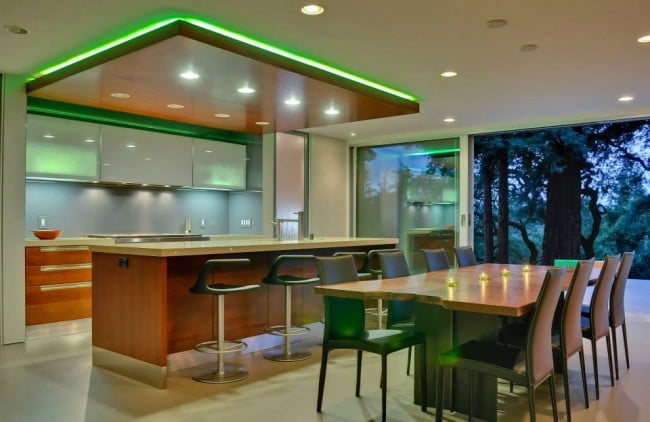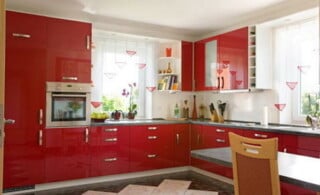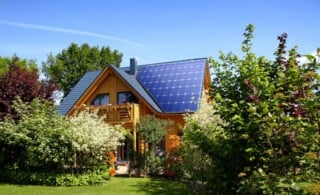
Green is the most recent catchword in the home improvement industry, a synonym for all things new, innovative, and environmentally friendly. It’s an interesting development, especially when you consider that the color green isn’t exactly a stranger when it comes to kitchens.
Take fried green tomatoes, for instance. This southern tradition has been around as long as the Whistlestop Cafe, inspiring a best-selling novel and a hit movie in the process! And it’s exactly that juxtaposition of old and new that can make going green in the kitchen such a conundrum for homeowners. Whether you’re gearing up for a complete kitchen remodel, or just want to make some eco-wise upgrades, here’s what the experts are saying about going green in one of the most important rooms in the home.
Lots of Green Potential: Energy Savings
Just as the character Ruth Jamison always believed in the potential of Idgie Threadgood in the movie Fried Green Tomatoes, the reason kitchens get so much attention in green circles is because they’re so full of possibility from a green perspective. According to Kirsten Ritchie, Director of Sustainable Design for the consulting and advising firm Gensler, “the kitchen is the most energy-intensive room in the house.” Why? In an article for GreenHomeGuide Ritchie answers that question, noting that the American addiction to excess is often to blame. “Do we really need refrigerators that can store 12 different bottles of barbecue sauce, eight different salad dressings, 14 containers of leftovers, etc.?” asks Ritchie. “And how big do we really need that microwave to be? Are we using it to defrost 30-pound turkeys (a bad idea), or simply to reheat small containers of leftovers? Bigger is definitely not better in this area.” In other words, when it comes to an area in your home where simple lifestyle changes can reap big green results, the kitchen is a great place to start.
Green Kitchens are Healthier Kitchens
Of course, vastly improved energy efficiency isn’t the only place you stand to benefit by going green in the kitchen. Just like Idgie Threadgood had a sensitive side to her rough exterior in the movie Fried Green Tomatoes, going green in the kitchen has more than one face to show the world, as well. The medium density fiberboard and interior grade plywood that many cabinets and countertops are made of can release dangerous amount of carcinogenic urea formaldehyde fumes into indoor environments, while the VOCs created by paints and stains further contaminate indoor air. There needs to be a constant reminder that toxic indoor air quality contributes to asthma, allergies, attention deficit disorders, cancer and many other illnesses. While the media typically covers energy, water, light and recycling, there is little discussed about sick air syndrome. Building, designing, and living in a healthy home should be high on the priority of lists for going green.
What Can You Do to Go Green?
What is the best way for you, as a homeowner, to embrace green in your kitchen? According to Forbes magazine, appliances are the best place to start. “The typical refrigerator uses 4.6 million Btu per year, according to the U.S. Department of Energy,” cites a Forbes article on the rise of green kitchen appliances, a figure that adds up to “nearly 5% of total household annual electricity consumption.” Contrast those statistics with a refrigerator highlighted in the same article that cuts electrical use at that appliance by over 30%, and you get the idea. Other energy-saving appliance choices include induction cooktops that can reduce stovetop energy use by 90%, new dishwashers that reduce the energy you use to wash dishes by as much as 41%, and microwave ovens that can cook food using 80% less energy than a conventional oven.
On the health front, things get a little more complicated. Green remodeling guru David Johnston recommends in his book, Green Remodeling: Changing the World One Room at a Time, that homeowners choose formaldehyde free cabinet and countertop materials, low or no VOC (volatile organic compounds) paints and stains, and water based adhesives rather than those that use petroleum based solvents. He also stresses the importance of good ventilation in the form of range hoods and lots of windows, just to be safe. In short, don’t let reducing energy consumption dominate your green kitchen goals. Taking steps in a positive direction when it comes to creating a healthy kitchen is equally important.
The Cost of a Green Kitchen
Finally, what does a green kitchen cost these days? In all honesty, it’s hard to say. So much of it depends on whether your kitchen is a few hundred square feet, or a couple thousand, that it’s nearly impossible to quote reliable ballpark estimates. Nevertheless, in her Washington Post article “Eco-Friendly in the Kitchen,” Lila Guterman found that the estimates she got from contractors to build a “green” kitchen were consistently 20% to 30% more than a traditional kitchen remodel. That might sound like a hefty price tag, but when you figure in a healthier home, reduced energy costs, and eco-peace-of-mind, it makes sense why more and more homeowners are deciding that the extra 20% to 30% is well worth the money spent.
No Need to Shoot for the Moon
Finally, what if that 20% to 30% is more than you?re willing, or able, to spend? Never fear. Going green doesn’t have to mean spending thousands, or tens of thousands, of dollars on a major kitchen remodel. Harkening back to our Friend Green Tomato discussion, sometimes the least complicated plans are best. After all, who can forget the fate of Ruth’s abusive ex-husband at the Whistlestop Cafe? BBQ ribs anybody? Obviously, cannibalism is never the answer, but making green decisions on a smaller level in the kitchen does make a difference. Choosing long lasting pots and pans (stainless steel and cast iron), using reusable storage containers rather than disposable ones, and repainting or refinishing old cabinets rather than sending your existing set to the landfill, are all smart steps in a green direction.
How green you want to go in the kitchen is up to you. The trick is making the commitment, and then making it happen. Towanda!
 Green Kitchen Remodels
Green Kitchen Remodels  How Can I Remodel for a Vintage-Style Kitchen?
How Can I Remodel for a Vintage-Style Kitchen?  Corner Bathroom and Kitchen Sinks
Corner Bathroom and Kitchen Sinks  Sustainable Home Improvements that Help Save the Planet
Sustainable Home Improvements that Help Save the Planet  Green Building Glossary
Green Building Glossary 

Are You Familiar With This Topic? Share Your Experience.